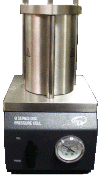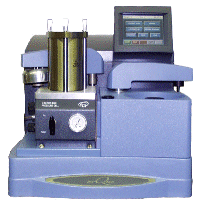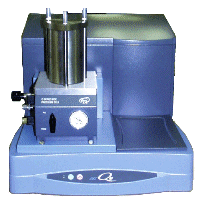 About the DSC Pressure Cell
About the DSC Pressure Cell About the DSC Pressure Cell
About the DSC Pressure Cell
When you receive your DSC Pressure Cell (PDSC), there will be some installation required, as well as safety and operational considerations, and maintenance.
Select from the following topics for more information:










 The Pressure DSC (PDSC) cell (shown to the right) is a
DSC cell enclosed in a steel cylinder that can be pressurized to 7 MPa
gauge (1000 psig). In addition to performing most of the same basic measurements
as a standard DSC cell, the PDSC cell can operate at elevated pressure
or under vacuum. This ability to vary pressure as well as temperature
provides the following:
The Pressure DSC (PDSC) cell (shown to the right) is a
DSC cell enclosed in a steel cylinder that can be pressurized to 7 MPa
gauge (1000 psig). In addition to performing most of the same basic measurements
as a standard DSC cell, the PDSC cell can operate at elevated pressure
or under vacuum. This ability to vary pressure as well as temperature
provides the following:
Resolution of overlapping peaks
Determination of heats of vaporization and vapor pressure
Reaction rates in controlled atmospheres
Studies of pressure-sensitive reactions
The Pressure DSC cell has two gas flow control valves, a three-way valve, a pressure gauge, a pressure release valve, and gas pressure fittings on the side. An 8.3 MPa gauge (1200 psig) pressure relief valve and a pressure transducer are contained in the base of the cell.
The Pressure DSC cell uses a constantan (thermoelectric) disc as a primary heat-transfer element producing Heat Flow T1. A silver heating block, capped with a vented silver lid, encloses the constantan disc. The selected sample and an inert reference are placed in pans that sit on raised portions of the disc. Heat is transferred through the constantan disc to both the sample and the reference pans. Differential heat flow to the sample and reference are monitored by the CHROMEL®-constantan area thermocouples. The thermocouples are formed at the junctions of the constantan disc and the CHROMEL® wafers welded to the underside of the two raised portions of the disc. CHROMEL® and ALUMEL® wires are connected to the sample CHROMEL® wafer at the thermocouple junction to measure sample temperature. An ALUMEL® wire is welded to the reference wafer for thermal balance. The furnace control thermocouple is CHROMEL®-constantan.
 Purge gas, entering the heating block through an inlet
in the Pressure DSC cell’s base, is preheated to block temperature by
circulation before entering the sample chamber through the purge gas inlet.
Gas exits through the vent hole in the silver lid.
Purge gas, entering the heating block through an inlet
in the Pressure DSC cell’s base, is preheated to block temperature by
circulation before entering the sample chamber through the purge gas inlet.
Gas exits through the vent hole in the silver lid.
The Pressure DSC cell is available as an optional operator-replaceable cell for the DSC Q2000/Q1000 (shown in the figure to the right).
It is also available as part of an integrated DSC Q10P/Q20P system (shown in the figure below).

CHROMEL® and ALUMEL® are registered trademarks of Hoskins Manufacturing Company.
CAUTION: The operator of this instrument is advised that if the equipment is used in a manner not specified in this document, the protection provided by the equipment may be impaired.
WARNING: If excessive amounts of hydrocarbons are present in the Pressure DSC (PDSC), energetic combustion could occur causing damage to the Pressure DSC cell and possible injury to the operator. To help prevent these problems, follow the guidelines below:
WARNING: (1) Clean Supply Lines: The oxygen supply lines, valves, gauges, and regulators must all be free of hydrocarbons and rated for oxygen service. Check with your supplier if you are uncertain whether a component is rated for oxygen service. If the inside of the tubing smells “oily” or has liquid or a black carbon residue in it, hydrocarbons may be present. Consult with your compressed gas suppliers for a cleaning procedure.
WARNING: (2) Cell Contamination: Remove the pressure housing and visually inspect the Pressure DSC cell for oil or other organic contamination. The entire oxygen pressure system must be free of hydrocarbons. If there is a possibility of hydrocarbon contamination (spilled samples, oily residue, oily smell, carbon black, etc.) in your Pressure DSC cell, immediately discontinue use. Contact TA Instruments Service at (302) 427-4050 to schedule a safety inspection or for additional information.
WARNING: (3) Check all Supply Tubing. All tubing connecting your Pressure DSC cell to other devices (oxygen cylinder, gauges, valves, regulators, etc.) should be 0.125 in. O.D. All plumbing, valves, gauges, and regulators must be rated for high pressure service to 21 MPa gauge (3000 psig) and be free of hydrocarbons.
You should review the warnings above if you plan to use oxygen in the PDSC and any of the following conditions apply to you.
New installation of a PDSC
Modification of supply lines, valves or gauges
Sample was spilled in the PDSC
PDSC has an “oily” smell
PDSC has not been used recently.
You may ensure safe operation of your Pressure DSC if you follow the important safety instructions and warnings as directed.
DO NOT use hydrogen or any other highly flammable gas with the standard Q Series™ DSC cells.
WARNING: Hydrogen gas should be used with extreme care. It is highly flammable when exposed to flame or oxidizing materials. [The Sax Safety Handbook, Dangerous Properties of Industrial Materials, indicates that the lower explosion limit (LEL) under ambient conditions for hydrogen is 4.1% in air. Care should be taken to keep the concentration below this value.] When using hydrogen in the Pressure DSC cell, the cell should be initially purged thoroughly with helium before introducing hydrogen.
CAUTION: When hydrogen or helium is used as a pressurizing gas, the maximum temperature or maximum heating rate may be less than the specification.
WARNING: At the end of the experiment, the cell should be vented into an exhaust hood and repurged with helium prior to opening the pressure container.
WARNING: Check all supply tubing. All tubing connecting your Pressure DSC cell to other devices (such as hydrogen cylinders, gauges, regulators, etc.) should be 0.125 in. O.D. All plumbing, valves, gauges, and regulators must be rated for high pressure service to 21 MPa gauge (3000 psig) and all connections between items should be tight and leak-free.
At the end of the experiment, the cell should be vented into an exhaust hood and repurged with helium prior to opening the pressure container.
Contact our U.S. Applications Hotline at (302) 427-4070 or your local TA Instruments Representative if you have any questions regarding the safe usage of the TA Instruments DSC Pressure Cells.
Use only the purge gases listed in Purge Gases and Flow Rates. Use of other gases could cause damage to the instrument or injury to the operator.
CAUTION: Do not remove the white, fibrous insulation from inside the cell cover.
CAUTION: The hold-down thumbscrews that hold the DSC pressure cell in place ensures proper mating with the electrical connections. You cannot run experiments without them. If they are not fully in place, the instrument may not be able to apply power to the cell and will not operate.
You must unplug the instrument before doing any maintenance or repair work; voltages as high as 120/240 Vac are present in this system.
WARNING: High voltages are present in this instrument. Maintenance and repair of internal parts must be performed only by TA Instruments or other qualified service personnel.
WARNING: Drying out the DSC cell may be needed, if it has been exposed to humid conditions. It is important to be certain that the instrument ground is adequately connected to the facilities ground for safe operation. Run the "Cell/Cooler Conditioning" test template to dry out the cell: (1) Ramp at 10°C/min to 400°C (2) Isothermal for 120 min.
The cell surfaces can be hot enough to burn the skin during a sample run. If you are conducting a subambient test using the DSC pressure cell, cold could also cause injury. After running any type of experiment, you must allow the pressure cell to return to room temperature before you touch the inner cell surfaces.
The primary maintenance procedures described in this section are the customer’s responsibility. Any further maintenance should be performed by a representative of TA Instruments or other qualified service personnel.
See also: Cleaning a Contaminated Pressure Cell
WARNING: Because of the high voltages in this instrument, untrained personnel must not attempt to test or repair any electrical circuits.
If sinusoidal baseline noise is observed in a PDSC heat flow curve obtained under pressure, the silver lid and gas ring (the silver ledge on which the lid sits) may have become slightly warped and should be smoothed with the lapping tool before the next run. The lapping tool is provided with the PDSC Cell.
Place the silver lid, handle side up, on a piece of fine (600 grit) emery paper backed by a flat, smooth surface, and move the lid in a figure-eight motion until any deformed areas are smoothed.
To smooth the gas ring, attach a piece of abrasive paper (400 grit) to the lapping tool with the double-sided tape provided. Trim the paper to the size of the tool using scissors or a razor knife. Rotate the lapping tool (PN 008837.001) back and forth on the ring with light-to-moderate pressure. Clean afterward with a fiberglass brush and a light air blast.
NOTE: Be sure to wear safety glasses or goggles when cleaning the cell with air.